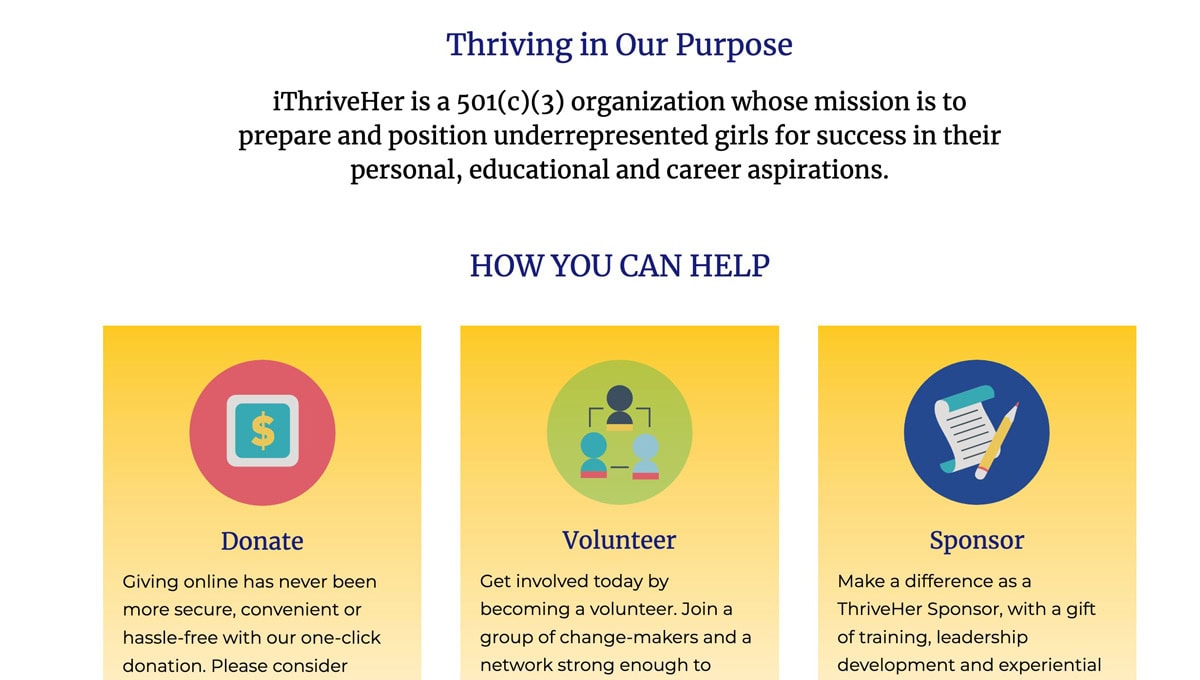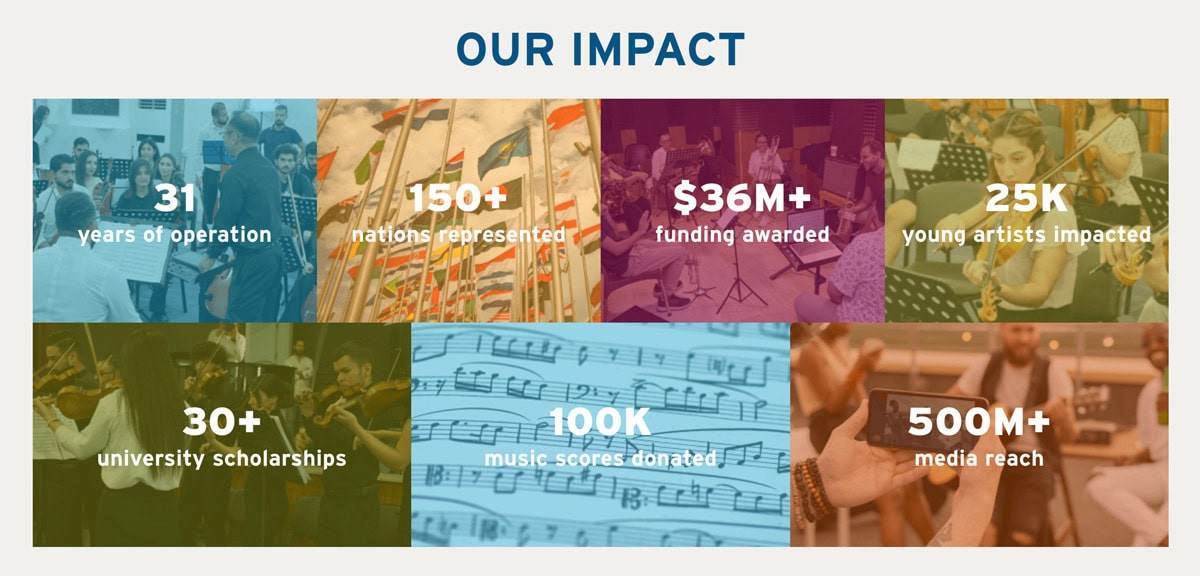5 Essential Elements Every Nonprofit Website Should Have
Creating an effective website for a nonprofit organization is crucial to its success. A well-designed website can help build credibility, engage supporters, attract donors, and clearly communicate the mission and values of the organization. In order to accomplish these important goals, there are five essential elements we believe that every nonprofit website should have:
- Clear and Compelling Mission Statement
- Engaging Storytelling and Impact Reports
- User-Friendly Donation Process
- Volunteer and Engagement Opportunities
- Responsive Design and Accessibility
1. Clear and Compelling Mission Statement
Your mission statement is the heart of your nonprofit organization. It communicates who you are, what you do, and why you do it. It should be prominently displayed on your homepage and other key pages. A clear and compelling mission statement can quickly convey your purpose to visitors and inspire them to get involved or support your cause.
Key Elements:
- Visibility: Place your mission statement at the top of your homepage or in a dedicated section that is easily accessible.
- Brevity: Keep it concise and to the point. Aim for a few sentences that capture the essence of your organization.
- Emotion: Use language that resonates emotionally with your audience. You want to evoke a sense of urgency and importance.
- Consistency: Ensure your mission statement is consistent across all platforms, including social media and print materials.
Example: If your nonprofit is focused on providing clean water to underdeveloped regions, a mission statement might be: “Our mission is to bring safe and sustainable water solutions to communities in need, ensuring every person has access to clean water.”

2. Engaging Storytelling and Impact Reports
People connect with stories. By sharing the real-life impact of your work, you can make your mission more tangible and relatable. Use storytelling to highlight the personal journeys of individuals or communities your organization has helped. This approach not only humanizes your cause but also demonstrates transparency and accountability.
Key Elements:
- Success Stories: Share detailed accounts of how your organization has made a difference. Include quotes, photos, and videos where possible.
- Impact Statistics: Provide data and metrics that quantify your impact. For example, the number of people served, projects completed, or funds raised.
- Annual Reports: Publish annual impact reports that offer a comprehensive overview of your achievements over the year. Make these reports visually appealing and easy to understand.
- Multimedia: Use a mix of text, images, and videos to create a richer, more engaging experience for visitors.
Example: A nonprofit focused on education might share a story about a student whose life was changed through their scholarship program, including before-and-after photos and a personal testimonial from the student.

3. User-Friendly Donation Process
Donations are the lifeblood of many nonprofit organizations. A complicated or frustrating donation process can deter potential donors. Your website should make it as easy as possible for visitors to contribute financially to your cause.
Key Elements:
- Prominent Donation Buttons: Place clear and visually appealing donation buttons in multiple locations on your website, including the homepage, about page, and within blog posts.
- Simplified Forms: Keep donation forms short and straightforward. Only ask for essential information to minimize barriers.
- Multiple Payment Options: Offer various payment methods, such as credit cards, PayPal, and other digital wallets, to accommodate different preferences.
- Recurring Donations: Provide an option for donors to set up recurring donations to support your organization on an ongoing basis.
- Thank You Pages: After a donation is made, redirect donors to a thank you page that acknowledges their contribution and explains its impact. Follow up with a personalized thank you email.
Example: Consider embedding a donation form directly on your website rather than redirecting to a third-party site. This can enhance the user experience and increase the likelihood of completing the donation.
4. Volunteer and Engagement Opportunities
Volunteers are vital to many nonprofit organizations. Providing clear and accessible information about how people can get involved can help you attract and retain volunteers. Additionally, creating engagement opportunities allows supporters to participate in ways beyond financial contributions.
Key Elements:
- Volunteer Sign-Up Forms: Include a dedicated section for volunteer opportunities with detailed descriptions and a sign-up form.
- Event Calendars: Maintain an up-to-date calendar of events, including fundraisers, community activities, and volunteer opportunities.
- Social Media Integration: Encourage visitors to follow your organization on social media to stay updated on events and news.
- Newsletter Sign-Up: Offer a newsletter sign-up to keep supporters informed about your activities and impact.
- Advocacy Campaigns: Provide information on how supporters can advocate for your cause, such as signing petitions, contacting legislators, or participating in awareness campaigns.
Example: A nonprofit focused on animal welfare might have a volunteer page listing opportunities to help at local shelters, participate in adoption events, or foster animals in need.
5. Responsive Design and Accessibility
In today’s digital age, people access websites from a variety of devices, including smartphones, tablets, and desktop computers. A responsive design ensures your website looks great and functions well on all screen sizes. Additionally, accessibility is crucial to ensure that your website is usable by everyone, including people with disabilities.
Key Elements:
- Mobile-Friendly: Use responsive design techniques to ensure your website is mobile-friendly. This means text is readable without zooming, navigation is easy, and buttons are tappable.
- Fast Load Times: Optimize your website for speed. Slow-loading pages can frustrate visitors and lead to higher bounce rates.
- Accessible Content: Follow web accessibility guidelines (such as WCAG) to make your website usable for people with disabilities. This includes providing alt text for images, using proper heading structures, and ensuring forms are navigable via keyboard.
- Readable Fonts and Colors: Use legible fonts and high-contrast color schemes to improve readability for all users.
Example: Ensure your website is tested across different devices and browsers to catch any issues and provide a seamless experience for all users. Tools like Google’s Mobile-Friendly Test and WAVE Accessibility Tool can help with this.

Beyond the Essentials: Enhancing Your Nonprofit Website
While the five elements outlined above are crucial, there are additional features and strategies that can further enhance your nonprofit website’s effectiveness and user experience.
Integrated Social Media and Blogging
Social media is a powerful tool for nonprofits. Integrate social media feeds on your website to keep visitors updated with your latest posts, events, and news. Additionally, maintaining an active blog can help drive traffic to your site, engage your audience with in-depth stories, and improve your site's search engine optimization (SEO).
Key Elements:
- Social Media Feeds: Embed live feeds from platforms like Facebook, Twitter, and Instagram on your homepage or in a dedicated social media section.
- Share Buttons: Add social media share buttons to your blog posts and other key pages to encourage visitors to spread the word.
Regular Blog Posts: Publish regular blog posts that cover a variety of topics related to your mission. These can include success stories, updates on projects, and thought leadership articles.
Example: A nonprofit focused on environmental conservation might blog about recent conservation efforts, upcoming events, and tips for living sustainably.
Search Engine Optimization (SEO)
SEO is essential for increasing your website’s visibility on search engines like Google. By optimizing your website for relevant keywords, you can attract more organic traffic from people interested in your cause.
Key Elements:
- Keyword Research: Identify and use keywords related to your nonprofit’s mission throughout your website’s content.
- Meta Tags: Optimize meta titles and descriptions for each page to improve click-through rates from search engine results.
- Quality Content: Regularly update your site with high-quality, informative content that provides value to your audience.
Internal and External Links: Use internal links to guide visitors to other relevant pages on your site and external links to reputable sources to improve credibility.
Example: A nonprofit dedicated to mental health might target keywords like “mental health resources,” “how to support mental health,” and “mental health awareness.”
Analytics and Performance Tracking
Understanding how visitors interact with your website is crucial for continuous improvement. Use analytics tools to track performance metrics and gain insights into visitor behavior.
Key Elements:
- Google Analytics: Set up Google Analytics to monitor traffic, user behavior, and conversion rates.
- Heatmaps: Use heatmaps to visualize where visitors click and how they navigate your site.
- Feedback Forms: Incorporate feedback forms to gather visitor opinions and suggestions.
Example: Regularly review your analytics data to identify which pages are most popular, how long visitors stay on your site, and where they drop off. Use this information to make informed improvements.
Conclusion
Incorporating these essential elements into your nonprofit website can significantly enhance its effectiveness and impact. A clear mission statement, engaging storytelling, user-friendly donation process, volunteer and engagement opportunities, and responsive design all work together to create a compelling and functional online presence.
By focusing on these key areas, you can ensure that your website not only attracts and retains supporters but also effectively communicates your organization's mission and values, ultimately driving greater impact for your cause.
Remember, your website is often the first point of contact for potential supporters, so investing time and resources into making it as strong as possible is well worth the effort.